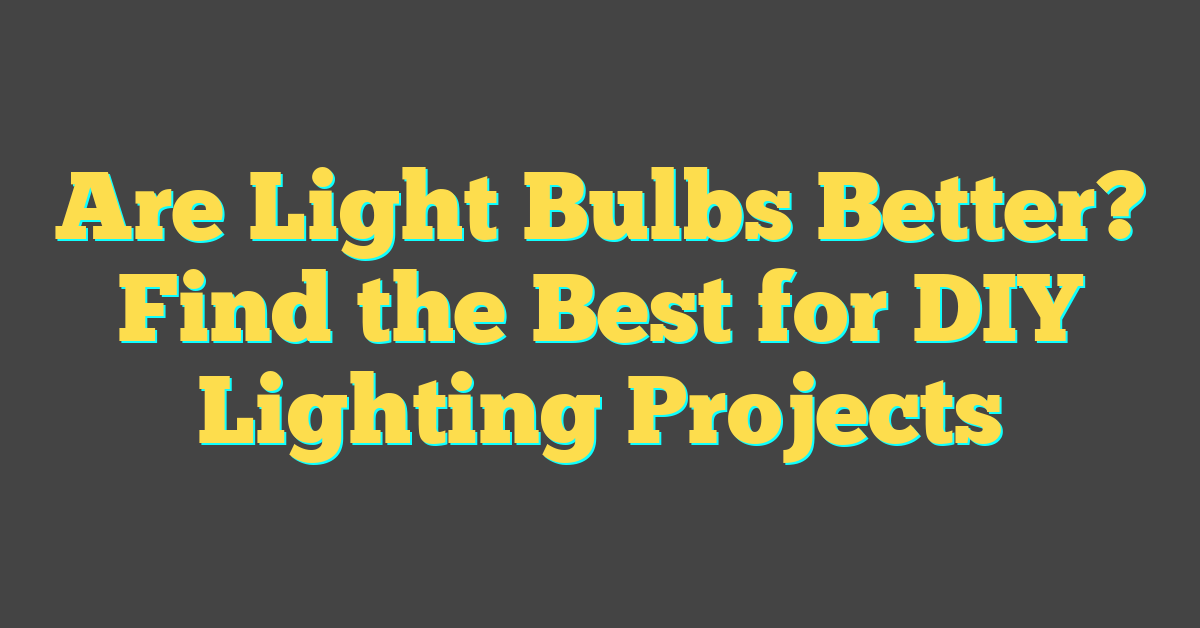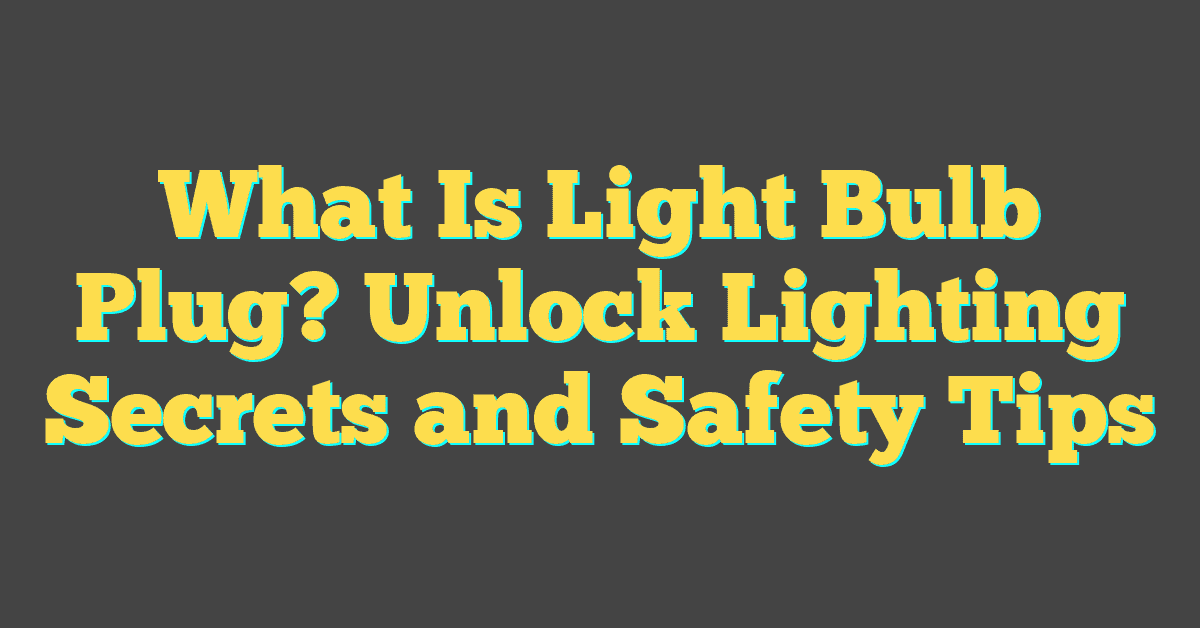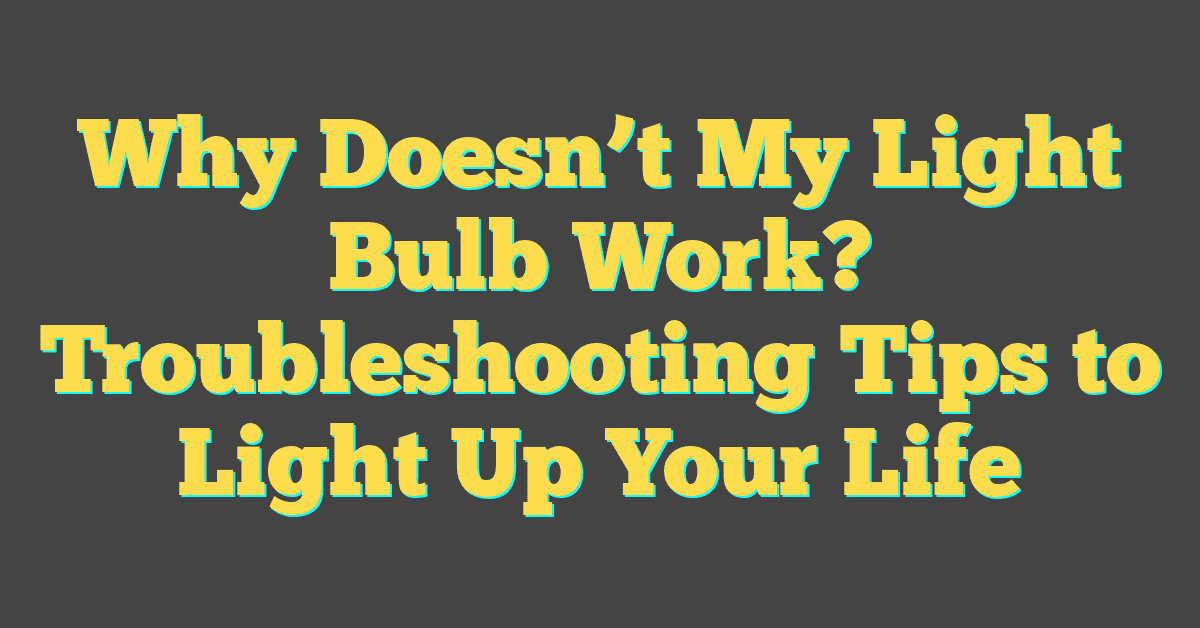Ever wondered if all light bulbs are created equal? You’re not alone. With the dizzying array of options on the market, it’s natural to question which ones truly outshine the rest.

You’ll find that the answer isn’t just about brightness. It’s about energy efficiency, longevity, and even the quality of light that fills your space. Let’s shed some light on the subject and discover which bulbs are worth your investment.
Types of Light Bulbs
Exploring the world of light bulbs, you’ll find a multitude of options, each with unique benefits and uses. Here’s a crash course on the main types you’ll likely consider for your home DIY lighting projects.
Incandescent Bulbs: These are the traditional bulbs that most folks grew up with. You might appreciate their warm glow, but they’re not the energy savers of today. Plus, they tend to have a shorter lifespan compared to other modern alternatives. Incandescents work well for ambient lighting and are dimmable, which is a bonus for creating mood lighting.
LED Bulbs (Light Emitting Diodes): If you’re gunning for efficiency, LED bulbs are where it’s at. They use up to 90% less energy than traditional incandescent bulbs and can last an impressive 15-25 times longer. With various hues and dimmable options, LEDs have you covered whether you’re after a cozy atmosphere or bright task lighting.
CFL Bulbs (Compact Fluorescent Lamps): Bridging the gap between incandescent light quality and LED energy efficiency, CFL bulbs are a solid middle ground. They need a bit of time to warm up to their full brightness, but once they do, they consume about 70% less energy than incandescents. However, they contain mercury, which requires careful disposal.
Halogen Bulbs: Coming in closest to replicating the look of natural daylight, halogens are the pick-me-up for any drab space. They’re more energy-efficient than incandescent bulbs but fall short when compared to LEDs and CFLs. Due to their high operating temperatures, they may not be ideal in all settings.
When choosing bulbs, consider not just the energy efficiency and longevity, but also the quality of light each type provides. It’s vital to match the bulb to the function – whether that’s reading, highlighting artwork, or illuminating your entire living room. Your choices will shape both the ambience and the impact on your energy bill, so choose wisely and let your creatively lit spaces speak volumes about your DIY prowess.
Energy Efficiency

When you’re in the market for light bulbs, considering energy efficiency is crucial. LED bulbs are a game-changer in this department. Compared to traditional incandescent bulbs, LEDs use about 75% less energy and can last up to 25 times longer. Their design ensures that most of the energy they consume is converted into light, not wasted as heat.
CFLs, or compact fluorescent lamps, are also known for their energy-saving attributes. These bulbs use roughly about 70% less energy than incandescents and have a longer lifespan, although not quite as long as LEDs. Halogen bulbs, while more efficient than old-school incandescent bulbs, still lag behind LEDs and CFLs in terms of energy efficiency and longevity.
Let’s break down some numbers to give you a clearer picture:
| Bulb Type | Energy Use (Watts) | Lifespan (hours) |
|---|---|---|
| Incandescent | 60 | 1,200 |
| LED | 15 | 25,000 |
| CFL | 14 | 10,000 |
| Halogen | 43 | 2,000 |
As you can see, the wattage significantly drops from incandescents to LEDs and CFLs. This drop reflects on your energy bills, showing considerable savings over time. Furthermore, with longer lifespans, you won’t be replacing your LEDs nearly as often as you would with incandescents, which is both convenient and cost-effective.
While the initial cost may be higher for LEDs, the investment pays off. The steep reduction in power consumption and the infrequent need for replacements make LEDs the leading choice for most energy-conscious DIYers. Remember, incorporating energy-efficient lighting into your home is a straightforward way to reduce your carbon footprint and contribute to a greener planet. And who wouldn’t want to save the planet while saving some cash at the same time?
Longevity

« What Is the Best Light Bulb for a Dining Room? Find the Perfect Glow Now
Is Light Bulb Brightness Key to Room Vibes? Find Your Perfect Glow »
When you’re delving into DIY lighting projects, it’s not just about the upfront costs of materials; you’ve also got to consider how long those swanky new light bulbs will last. Think about it – time is money, and the less time you spend climbing ladders to replace burnt-out bulbs, the better.
Let’s break down the lifespan of these luminous contenders:
- LED bulbs: the marathon runners of lighting, LEDs boast an impressive lifespan ranging from 20,000 to 50,000 hours.
- CFL bulbs: the middle-distance athletes, CFLs have a respectable run of about 8,000 to 15,000 hours.
- Halogen bulbs: sprinters in the race, halogens keep shining for approximately 1,000 to 5,000 hours.
- Incandescent bulbs: with a quicker burnout, they have the shortest relay of about 750 to 2,000 hours.
Here’s a clearer picture put into a table for you:
| Bulb Type | Lifespan Range (hours) |
|---|---|
| LED | 20,000 to 50,000 |
| CFL | 8,000 to 15,000 |
| Halogen | 1,000 to 5,000 |
| Incandescent | 750 to 2,000 |
This lifecycle is crucial because it plays into the total cost of ownership. You might shell out a bit more for an LED bulb compared to an incandescent, but when you consider the rate at which you’ll need to replace them, LEDs are the clear front runners. They’re the gift that keeps on giving, saving you time and trips to the store.
Factor in the environmental impact as well. Fewer bulb replacements mean less waste. By choosing long-lasting options like LEDs for your home, you’re not just cutting down on your to-do list; you’re also reducing your carbon footprint. It’s a win-win for both the savvy homeowner and Mother Earth.
Quality of Light

When you’re knee-deep in a home DIY project, the quality of light is as crucial as the tools you’re using. It’s not just about illuminating your space—it’s about creating the right ambiance and ensuring that the colors and details of your work are accurately represented.
LED bulbs shine in the quality of light they provide. Their light is clean and sharp, enhancing the vibrancy of colors with a high Color Rendering Index (CRI). This means when you switch on an LED bulb, the colors in your room look true to life, as if they’re basking in natural sunlight.
On the other hand, CFLs might cast a cooler, more diffused light that can affect the perception of colors. Although they’ve improved significantly, they generally don’t match the sharpness of LEDs. Halogens offer a warm glow and decent color accuracy, but they often fall short in consistency compared to LEDs.
And let’s not forget about dimmability. LEDs have made great strides here, providing you with the ability to adjust your lighting according to your mood or task at hand without losing much in terms of light quality. Sure, incandescent bulbs are known for their dimmable warm light, but they don’t hold a candle to the energy efficiency and lifespan of LEDs.
Light temperature is another aspect to consider. Measured in Kelvins (K), the temperature affects the warmth or coolness of the light. Incandescent bulbs usually give off a warm light around 2700K, while LEDs can range from a warm 2700K to a cool daylight of 6500K. It’s all about personal preference and the function of your space. Here’s a simplified table showing typical color temperatures for different bulb types:
| Bulb Type | Warm Light (~2700K) | Cool Light (~6500K) |
|---|---|---|
| LED | Yes | Yes |
| CFL | Yes | Yes |
| Halogen | Yes | No |
| Incandescent | Yes | No |
Ultimately, the quality of light in your home can affect everything from your productivity to your well-being. With the right bulb, you’ll not only save on energy but also create a pleasant environment for whatever project you’ve got in hand.
Making the Right Choice

When you’re immersed in home DIY lighting projects, you know that the possibilities are endless and picking the right light bulb is crucial. Your choice can influence the ambiance of a room, the accuracy with which you complete your projects, and even your energy bill.
For tasks that require precision and clarity, like intricate craftwork or reading, LEDs are your go-to option. The sharpness of the light ensures you won’t miss a single detail. If you’re working on something that doesn’t require such high definition, CFL bulbs could work just fine. They’re also great for areas where you want to avoid shadows since the light they cast is more diffused.
The warmth of a halogen bulb might be perfect for lighting up a cozy corner. Remember that halogens can get quite hot; therefore, they might not be the best choice for a tight workspace. On the other hand, if you’re after an old-school feel with a modern twist, newer incandescent bulbs that meet energy standards provide that familiar warm glow without running up your electricity bill.
Your lighting can also serve multiple purposes. Don’t hesitate to mix and match. An LED desk lamp might sit alongside a softer, CFL-lit backdrop, offering versatility in a multipurpose space.
Here’s a quick rundown to help you navigate your choice:
- Precision Tasks: Opt for LEDs
- Soft, Diffuse Lighting: Consider CFLs
- Cozy Atmosphere: Halogen could be ideal
- Warm, Traditional Glow: Look at energy-efficient incandescent bulbs
Lumens are also something you’ll want to pay attention to—the higher the lumens, the brighter the bulb. A good rule of thumb is to aim for 800 lumens if you’re replacing a standard 60-watt incandescent bulb. However, for accent lighting or a relaxed mood, you might want to go lower.
Above all, assess the needs of your space and match your lighting accordingly. Whether you’re wiring a new fixture or simply swapping out an old bulb, your project’s success hinges on making an informed decision—so take the time to consider your choices.
Conclusion
So you’ve seen that the right light bulb can completely transform your space and your energy bill. Whether you’re after the clear, focused illumination of LEDs for your intricate projects or the soft, diffused glow of CFLs for a cozy atmosphere, there’s a bulb out there that’s perfect for your needs. Remember, it’s not just about the type of bulb but also the lumens that make the difference. Don’t forget to assess your space and mix it up if necessary—after all, versatility is key in a multipurpose area. Now you’re all set to light up your home in the most efficient and aesthetically pleasing way possible. Happy lighting!
Frequently Asked Questions
What are the best light bulbs for DIY home lighting projects?
For tasks requiring precision and clarity, LED bulbs are ideal, while CFL bulbs are better for areas needing diffused lighting. Halogen bulbs provide a warm ambiance but may not be best for tight spaces due to their heat output.
How does the type of bulb affect a room’s ambiance?
The bulb type can significantly influence a room’s ambiance. LEDs offer bright and clear light, CFLs provide a diffused glow, and Halogen bulbs create a warm atmosphere. Incandescent bulbs emit a traditional warm glow.
Are energy-efficient bulbs also good for the quality of light?
Yes, energy-efficient bulbs like LEDs and CFLs provide good quality light while reducing energy consumption. The quality of light is suitable for various needs, including detailed projects and general room ambiance.
Can I mix and match different light bulbs in the same space?
Yes, mixing and matching different types of light bulbs is recommended for versatility, especially in multipurpose spaces. This approach allows you to adjust lighting based on the specific activity and desired ambiance.
What should I consider when choosing a bulb for a DIY project?
Consider the lumens for brightness, the type of bulb for the desired quality of light, and the energy efficiency. It’s also important to think about the specific needs of the space where you will be working or the room you’ll be lighting.




